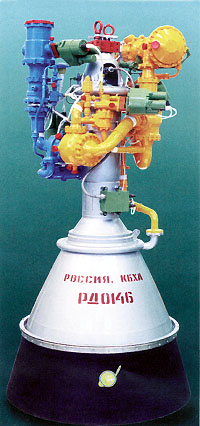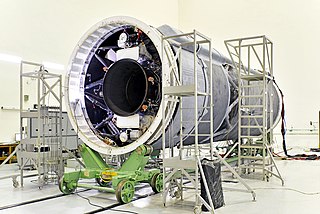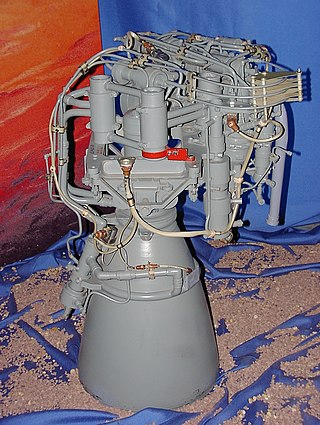Related Research Articles

Vostok was a family of rockets derived from the Soviet R-7 Semyorka ICBM and was designed for the human spaceflight programme. This family of rockets launched the first artificial satellite and the first crewed spacecraft (Vostok) in human history. It was a subset of the R-7 family of rockets.

Geosynchronous Satellite Launch Vehicle (GSLV) is a class of expendable launch systems operated by the Indian Space Research Organisation (ISRO). GSLV has been used in fifteen launches since 2001.

The Indian Space Research Organisation is the national space agency of India. It operates as the primary research and development arm of the Department of Space (DoS), which is directly overseen by the Prime Minister of India while the Chairman of ISRO also acts as the executive of DoS.

The staged combustion cycle is a power cycle of a bipropellant rocket engine. In the staged combustion cycle, propellant flows through multiple combustion chambers, and is thus combusted in stages. The main advantage relative to other rocket engine power cycles is high fuel efficiency, measured through specific impulse, while its main disadvantage is engineering complexity.

The Launch Vehicle Mark-3 or LVM3 is a three-stage medium-lift launch vehicle developed by the Indian Space Research Organisation (ISRO). Primarily designed to launch communication satellites into geostationary orbit, it is also due to launch crewed missions under the Indian Human Spaceflight Programme. LVM3 has a higher payload capacity than its predecessor, GSLV.

GSAT-4, also known as HealthSat, was an experimental communication and navigation satellite launched in April 2010 by the Indian Space Research Organisation on the maiden flight of the Geosynchronous Satellite Launch Vehicle Mk.II rocket. It failed to reach orbit after the rocket's third stage malfunctioned. The third stage was the first Indian-built cryogenic-fuelled upper stage, and was making its first flight. The ISRO suspects that the failure was caused by the third stage not igniting.

Gaganyaan is an Indian crewed orbital spacecraft intended to be the formative spacecraft of the Indian Human Spaceflight Programme. The spacecraft is being designed to carry three people, and a planned upgraded version will be equipped with rendezvous and docking capabilities. In its maiden crewed mission, the Indian Space Research Organisation (ISRO)'s largely autonomous 5.3-metric ton capsule will orbit the Earth at 400 km altitude for up to seven days with a two- or three-person crew on board. The first crewed mission was originally planned to be launched on ISRO's HLVM3 rocket in December 2021. As of October 2023, it is expected to be launched by 2025.

The Vikas is a family of hypergolic liquid fuelled rocket engines conceptualized and designed by the Liquid Propulsion Systems Centre in the 1970s. The design was based on the licensed version of the Viking engine with the chemical pressurisation system. The early production Vikas engines used some imported French components which were later replaced by domestically produced equivalents. It is used in the Polar Satellite Launch Vehicle (PSLV), Geosynchronous Satellite Launch Vehicle (GSLV) and LVM3 for space launch use.

A cryogenic rocket engine is a rocket engine that uses a cryogenic fuel and oxidizer; that is, both its fuel and oxidizer are gases which have been liquefied and are stored at very low temperatures. These highly efficient engines were first flown on the US Atlas-Centaur and were one of the main factors of NASA's success in reaching the Moon by the Saturn V rocket.

The RD-0146 (РД-0146) is a liquid-fuel cryogenic rocket engine developed by KBKhA Kosberg in Voronezh, Russia.

The CE-20 is a cryogenic rocket engine developed by the Liquid Propulsion Systems Centre (LPSC), a subsidiary of the Indian Space Research Organisation (ISRO). It has been developed to power the upper stage of the LVM3. It is the first Indian cryogenic engine to feature a gas-generator cycle. The high thrust cryogenic engine is the most powerful upper stage cryogenic engine in operational service.

The CE-7.5 is a cryogenic rocket engine developed by the Indian Space Research Organisation to power the upper stage of its GSLV Mk-2 launch vehicle. The engine was developed as a part of the Cryogenic Upper Stage Project (CUSP). It replaced the KVD-1 (RD-56) Russian cryogenic engine that powered the upper stage of GSLV Mk-1.
Kerala Hitech Industries Limited (KELTEC) was an Indian aerospace company in Thiruvananthapuram, Kerala. Its product-mix included systems required for the launch vehicles, satellite and non-rotating systems of turbojet aircraft engines. KELTEC was acquired by BrahMos Aerospace and rebranded as Brahmos Aerospace Trivandrum Ltd (BATL) in 2007.
GSAT-14 is an Indian communications satellite launched in January 2014. It replaced the GSAT-3 satellite, which was launched in 2004. GSAT-14 was launched by a Geosynchronous Satellite Launch Vehicle Mk.II, which incorporated an Indian-built cryogenic engine on the third stage.

The SCE-200 is a 2 MN thrust class liquid rocket engine, being developed to power ISRO's existing LVM3 and upcoming heavy and super heavy-lift launch vehicles. It is being developed by Liquid Propulsion Systems Centre (LPSC) of ISRO and is expected to have first flight in 2020s.

The S5.92 is a Russian rocket engine, currently used on the Fregat upper stage.

GSAT-6A was a communication satellite launched by the Indian Space Research Organisation (ISRO) It featured a 6-metre (20 ft) unfurlable S-band antenna similar to the one used on GSAT-6. Around 17 minutes after lift-off, the three stage GSLV Mk.II rocket flying on GSLV F08 mission successfully injected the satellite into a geosynchronous transfer orbit. Due to power failure during its orbit raising burns the communication was lost with GSAT-6A before it could reach its final circular geostationary orbit (GSO).
The Next Generation Launch Vehicle or NGLV is a three-stage partially reusable rocket, currently under development by the Indian Space Research Organisation (ISRO). This vehicle is designed to replace currently operational systems like PSLV, GSLV and LVM3.
References
- ↑ Brügge, Norbert. "Geosynchronous Satellite Launch Vehicle (GSLV)". B14643.de. Retrieved 2015-06-01.
- 1 2 Wade, Mark. "RD-56". astronautix.com. Encyclopedia Astronautica. Archived from the original on 2013-11-20. Retrieved 2014-01-07.
- ↑ "Двигатель КВД1. Кислородно-водородный блок 12КРБ" [Engine KVD-1. Hydrogen Oxygen unit 12KRB]. kbhmisaeva.ru (in Russian). KB KhIMMASH. Archived from the original on 2016-03-04. Retrieved 2015-08-03.
- ↑ "KVD-1 & S5.92 Brochure" (PDF). KB KhIMMASH. 1998-10-13. Retrieved 2015-08-03.
- ↑ "KVD-1 (left) with its precursor 11D56". ESA. Retrieved 13 May 2023.
- ↑ Rachuk, V.; Titkov, N. (2006). The First Russian LOX-LH 2 Expander Cycle LRE: RD0146 (PDF). 42nd Joint Propulsion Conference. Sacramento, California: AIAA/ASME/SAE/ASEE. doi:10.2514/6.2006-4904. AIAA 2006-4904.
- 1 2 "The long road to cryogenic technology". The Hindu. Chennai. April 21, 2011. Retrieved January 7, 2014.
- ↑ "Cryogenic Upper Stage (CUS)". justthe80.com. Archived from the original on February 23, 2014. Retrieved January 7, 2014.
- ↑ Laxman, Srinivas (Jan 6, 2014). "India overcame US sanctions to develop cryogenic engine". The Times of India . Archived from the original on January 8, 2014. Retrieved January 22, 2014.
